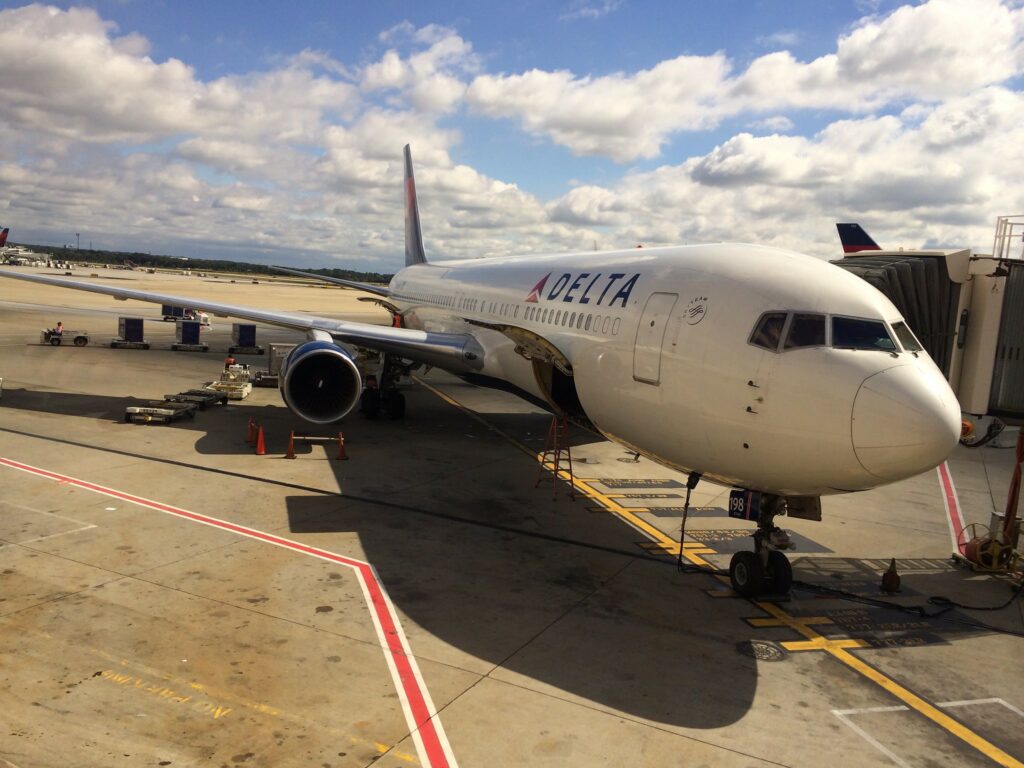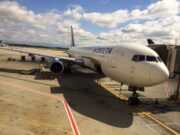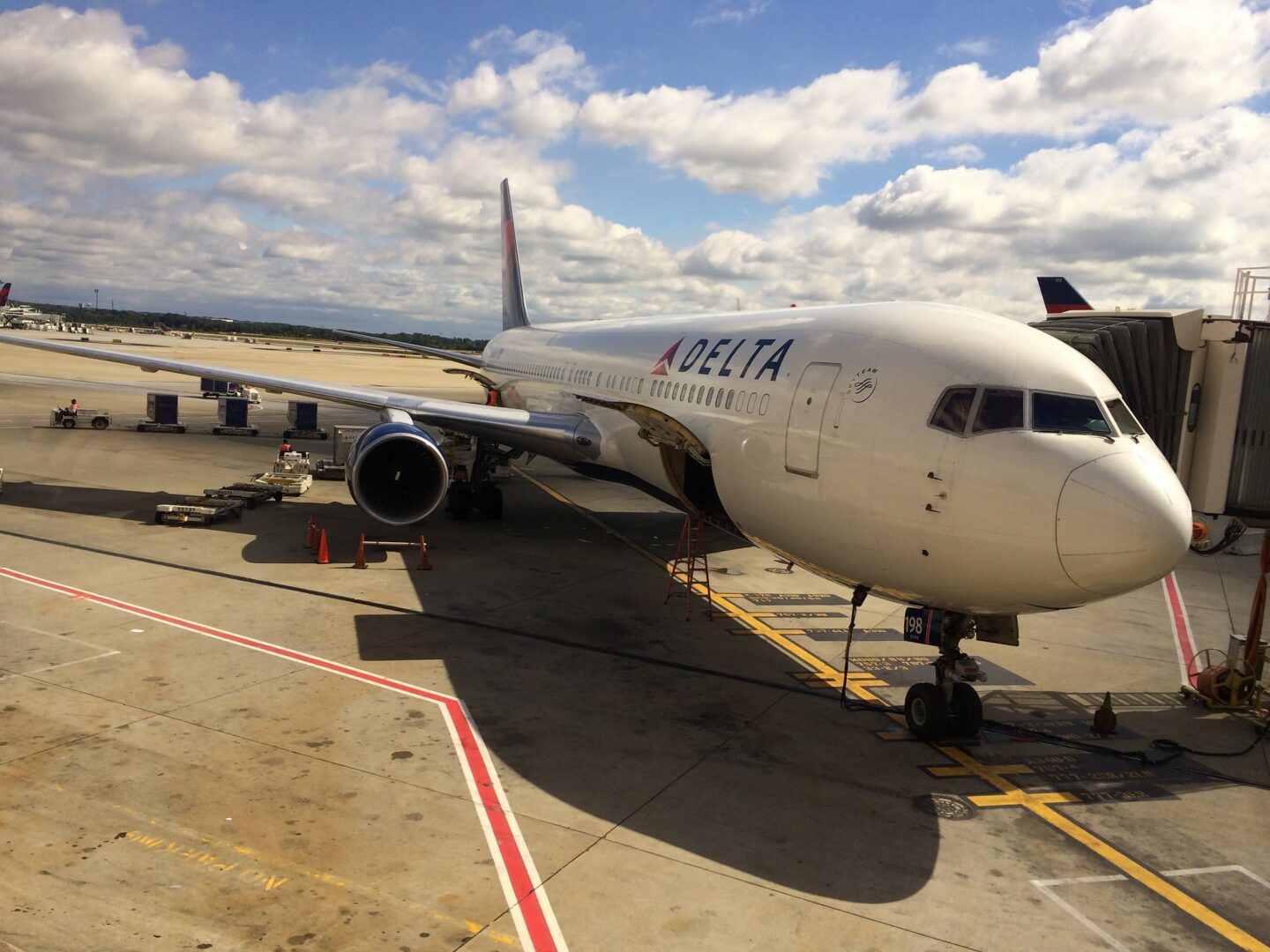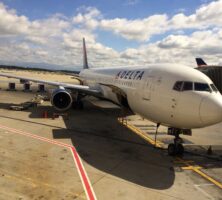Georgia has 107 public-use airports, the earliest of which emerged after World War I (1917-18). Many of the airports were converted from army air corps and naval air facilities used during World War II (1941-45). Since the mid-1960s the Georgia legislature has appropriated monies, supplemented by federal grants, for the state’s airport development.
Commercial-Aviation Airports
The nine commercial-aviation airports in Georgia traffic in major national and international airlines as well as commuter carriers. Atlanta’s Hartsfield-Jackson Atlanta International Airport is in a category by itself, a world-class facility that serves national and international traffic for much of the world. Savannah International Airport is second in terms of passengers served in the state. Augusta Regional at Bush Field and Columbus Metropolitan, which are next in order, facilitate national as well as commuter-passenger service.

Image from Bryan Jones
Five commercial-aviation airports in Georgia traffic in commuter service exclusively. In order of the number of passengers served, they are Southwest Georgia Regional (Albany), Middle Georgia Regional (Macon), Glynco Jetport (Brunswick), Valdosta Regional (Valdosta), and Athens–Ben Epps Airport (Athens). The nine Georgia commercial-aviation facilities (plus fifteen public-use general-aviation airports in such cities as Dublin, LaGrange, and Thomaston) are in a category of airports with runways that are 5,500 feet and longer.
General-Aviation Airports
Georgia has 98 public-use general-aviation airports throughout the state. The Georgia Airport Directory lists them alphabetically, from Cook County (Adel) to Wrens Memorial (Jefferson County). More than half of these airports have the intermediate runway lengths of 4,000 to less than 5,500 feet, such as those in Carrollton, Swainsboro, and Jesup. Airports in the shortest runway category, less than 4,000 feet, are in such small towns as Ellijay, Hawkinsville, and Quitman. General-aviation airports provide local residents and businesses with accessible facilities for both corporate and recreational flying. They relieve traffic at commercial-aviation facilities.
Excluding Hartsfield-Jackson Airport, Georgia’s system of commercial- and general-aviation airports generates more than $2 billion in economic activity and approximately 28,500 jobs, which provide in excess of $626 million annually in earnings. Georgia’s public-use airports are vital components in the state’s transportation infrastructure. They enable local businesses to tap markets and attract commerce from outside the state, and they create economic activity and jobs while facilitating business growth.
Historical Development: Through World War II
Georgia’s first airfield was at an army aviation school in Augusta. It operated briefly from 1911 to 1913, and Wilbur Wright visited there. During World War I the army air corps had airfields in the state; for example, planes landed at Souther Field, still the name of the airport in Americus. The renowned aviator Charles Lindbergh, in a war surplus plane, had his first solo training there in 1923, four years before his famous transatlantic flight.
The first civilian airfield in Georgia was in Athens, home of aviation pioneer Ben Epps. In 1922 the Clarke County commissioners approved use of the county farm as the Ben Epps Flying Field and allowed Epps to store his plane in a hangar that he constructed. Epps and his partner, L. Monte Rolfe, formed the Rolfe-Epps Flying Service, in a sense Georgia’s first air carrier of passengers. The Athens–Ben Epps Airport received steady upgrading throughout the 1930s. In 1940 the University of Georgia School of Aviation briefly operated the facility, which that same year became a naval air-training base with personnel quartered on the university campus. After World War II the airport ownership reverted to the city of Athens.
Shortly after World War II the federal government deeded other training bases to city or county governments. In 1947 army air corps bases were converted into civilian airports in Cordele, Donalsonville, Tifton (Henry Tift Myers Airport), LaGrange (Callaway Airport), Statesboro, Sylvania (Plantation Airpark), Vidalia, and Waycross. Similarly, there were conversions of navy flight-training facilities in Rome (Richard B. Russell Airport) and Gainesville (Lee Gilmer Memorial Airport).
Historical Development: The 1960s
By the early 1960s the federal government maintained only a few World War II military training air bases in Georgia, and there were some final transfers to civilian authorities. In 1961 Decatur County Industrial Air Park (Bainbridge) and Thomasville Municipal Airport (Thomasville) converted from army air corps facilities to local control.
In 1963 Governor Carl Sanders dedicated the Washington–Wilkes County Airport (Washington); the ceremony was the first of its kind performed by the state’s top elected official. (This facility’s administration building is unique, a 1785 dwelling moved from Oglethorpe County.) One ceremonial participant was Georgia’s famous manufacturer of pecan candy, Williamson S. Stuckey, whose pilot landed a Piper Aztec plane, symbolizing the growing role of air travel in the state’s economy.
The Sanders administration led a state aid program that supplemented federal grants to improve existing airports and to fund new facilities. In 1964 Sanders transferred monies from the governor’s emergency fund for construction of a new airport, Elbert County–Patz Field in Elberton. That same year the Georgia General Assembly began allocating funds for development of state airports as well as new construction, and appropriations in these areas have continued every year since.
In the 1960s there was growth in the standardization of safety measures for the state’s airports. In 1964 the first Georgia Weather Seminar and Flight Safety Clinic, in conjunction with federal authorities, was held near Hartsfield-Jackson Airport. In 1968 the Federal Aviation Administration (FAA) sponsored Georgia’s first annual flight instructor revalidation courses, held at Fulton County Airport–Brown Field. Also R. Dixon Speas Associates prepared that year Georgia’s first “Statewide Airport System Master Plan.” It noted that Georgia’s air facilities had increased in the 1960s by nearly 50 percent, and that the state was developing an excellent system of airports. Since then only about ten new facilities have been constructed. One goal of the controlled-growth policy is to improve the quality of the 107 public-use airports in Georgia.
Savannah: The Evolution of Georgia’s Second International Airport
In 1918 Savannah built its first airfield at Daffin Park, now near the center of the city, where aircraft operations continued for more than a decade. At the present site of Hunter Army Airfield, Savannah Municipal Airport opened in 1929. The first aircraft to land were planes inaugurating Eastern Air Express (later Eastern Air Lines) service between New York City and Miami, Florida. The facility’s first terminal building was an old trolley car.
In 1932 a city resolution named the airport Hunter Field, after local hero Frank Hunter, a World War I flying ace. During World War II the army air corps occupied Hunter Field. In 1940 Savannah acquired a land tract at Cherokee Hill, and construction began on a new airfield as a Work Projects Administration project. Until the end of World War II the army air corps also took over this facility, named it Chatham Field, and used it as a bomber base. In 1948 it became Travis Field in honor of Air Force Brigadier General Robert Travis and his brother Lieutenant Colonel William Travis. In the 1950s the federal government left Travis Field, and the Savannah Municipal Airport reopened there as a civilian facility with a new control tower and passenger terminal, under the Savannah Airport Commission.
In 1965 Delta Air Lines DC-9s first flew into Savannah, linking the city with all-jet service to New York; Chicago, Illinois; and Los Angeles and San Francisco, California. New runways improved Savannah’s prospects for international service. By 1968 Savannah Airport had its first long-range master plan, which projected an additional runway and a new terminal.
Through the 1970s there were numerous renovations at Savannah Municipal Airport, including a new control tower with approach radar, and more land was acquired for growth. In 1983 the Savannah Airport Commission changed the name of the facility to Savannah International Airport, recognizing that U.S. Customs is available for any direct overseas flights, much as the port of Savannah can process customs for international voyages. In 1994 the airport opened a new $43 million terminal with unique arch designs inspired by the town squares of historic Savannah. In 2002 the airport was renamed once more, becoming Savannah/Hilton Head International Airport, which today serves more than 1,700,000 passengers annually.
DeKalb Peachtree Airport: Georgia’s Second-Busiest Air Facility
DeKalb Peachtree Airport in Chamblee outside of Atlanta is an example of how Georgia general-aviation facilities have improved the state’s air transportation system and overall economy. PDK, as the airport is commonly called (each public-use airport has an official Department of Transportation code of letters and/or numbers), has averaged 230,000 operations—takeoffs and landings—annually for more than thirty years. PDK is the second-busiest airport in Georgia, behind only Hartsfield-Jackson.
PDK is for metropolitan Atlanta a “general reliever airport”; it helps reduce congestion by providing local service for smaller aircraft, allowing Hartsfield-Jackson to serve commercial airlines exclusively. General aviation at PDK includes corporate jets, aircraft charters, flight lessons, aircraft maintenance, personal planes for business and recreation, and helicopters.
DeKalb Peachtree Airport occupies the original site of Naval Air Station Atlanta, which operated from 1942 to 1959. Afterward the airport became a department of the DeKalb County government. By 1975 more than 400 aircraft, as well as 48 corporations, were based at PDK. In 1988 the FAA completed a $2 million, 130-foot freestanding control tower for the airport. In the 1990s PDK obtained a modern helipad, where most media organizations in Atlanta base their helicopters. Boxing great Muhammad Ali arrived at PDK in 1996 when he came to Atlanta to light the torch for the Olympic Games.
Today PDK has four aviation service companies, seven flight schools, and two helicopter operations. Corporations with flight departments at PDK include Bank of America, Southern Company, Kimberly-Clark, Post Properties, Rollins, and Honey Baked Ham. The airport consists of 765 acres, which encompass 4 runways (each more than 5,500 feet), 25 large hangars, and 90 smaller ones, with about 590 aircraft based at the facility.
PDK, which is financially self-sufficient, is the third-largest payer of property taxes in DeKalb County, responsible for an estimated 7,300 jobs, and generates approximately $130 million in income for local residents. In 2000 the National Air Transportation Association named PDK one of “America’s 100 Most Needed Airports,” critical for the growth of the nation’s aviation and economy.
Forecasts for the Future
The Georgia Department of Transportation (GDOT) forecasts that by the year 2012 almost 17 million passengers, double the 1992 figure, will originate travel in the state. Its recommended plan for outside the metropolitan Atlanta area is to not only improve existing commercial aviation airports in larger Georgia cities but also expand commuter service to five designated general-aviation airports. The facilities currently targeted are in Americus, Cornelia, Douglas, Dublin, and Rome. All have sponsoring agencies that will implement improvements.
In metropolitan Atlanta, the feasibility of proposed solutions remains unclear. The GDOT recommended an upgrade of Gwinnett County Airport–Briscoe Field in Lawrenceville to commercial air carrier status as a supplement to Hartsfield-Jackson. After Gwinnett citizens expressed concern, however, the state decided not to pursue any unwanted development of that airport. An upgrade of Fulton County Airport–Brown Field has been considered, but there has been little movement in this option.
Since the September 11, 2001, terrorist attacks in New York City and Washington, D.C., security has been substantially increased at Georgia’s airports, and disruptions have made commercial air travel more difficult. Industry experts note that commercial airline slowdowns are fueling growth in corporate flight departments, as well as private charters, in the state’s general-aviation airports.






